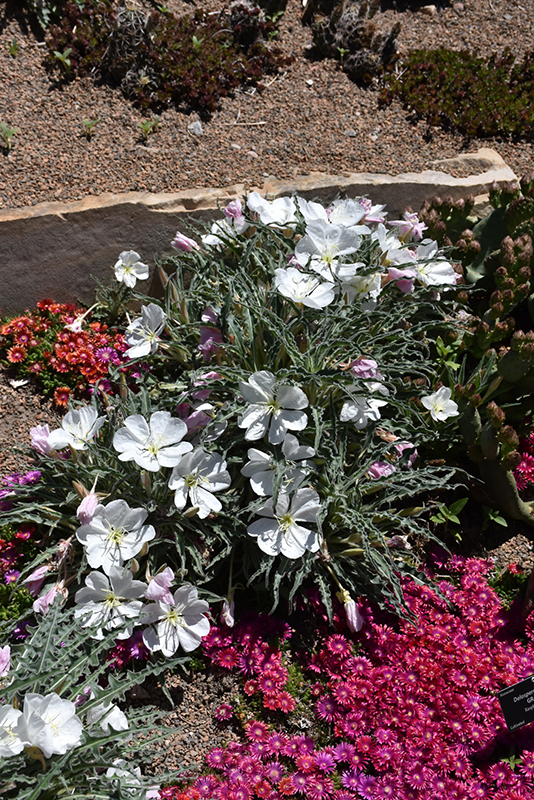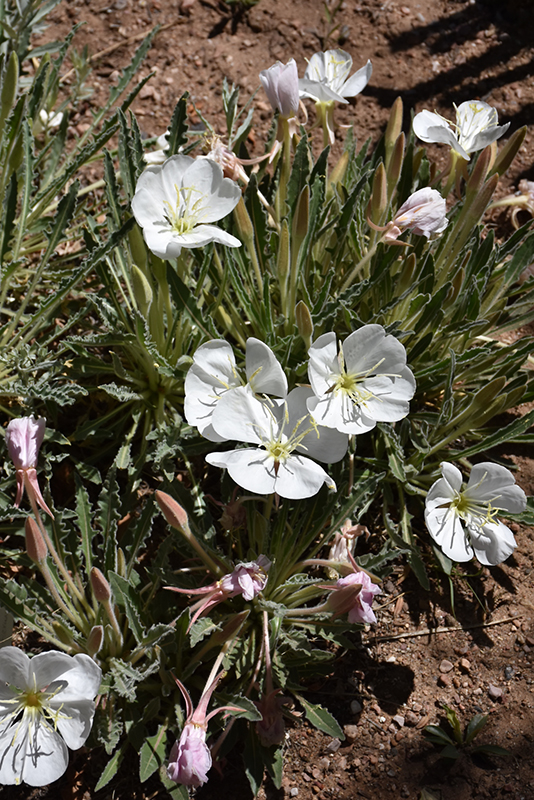Tufted Evening Primrose
Oenothera caespitosa
Plant Height: 8 inches
Flower Height: 12 inches
Spacing: 20 inches
Sunlight:
![]()
Hardiness Zone: 4a
Other Names: Gumbo Evening Primrose
Description:
A compact, prostrate plant with lance shaped, fuzzy, blue-green leaves; White flowers with yellow stamens appear above the foliage primarily in late spring to early summer, then fade to pink; a vigorous grower, great for rock gardens or border fronts
Ornamental Features
Tufted Evening Primrose has masses of beautiful lightly-scented white cup-shaped flowers with chartreuse eyes and yellow anthers along the stems from late spring to early fall, which are most effective when planted in groupings. Its attractive tomentose narrow leaves remain bluish-green in color throughout the season.
Landscape Attributes
Tufted Evening Primrose is an herbaceous perennial with a ground-hugging habit of growth. Its medium texture blends into the garden, but can always be balanced by a couple of finer or coarser plants for an effective composition.
This is a high maintenance plant that will require regular care and upkeep, and is best cleaned up in early spring before it resumes active growth for the season. It is a good choice for attracting birds to your yard, but is not particularly attractive to deer who tend to leave it alone in favor of tastier treats. Gardeners should be aware of the following characteristic(s) that may warrant special consideration;
- Spreading
Tufted Evening Primrose is recommended for the following landscape applications;
- Mass Planting
- Rock/Alpine Gardens
- Border Edging
- General Garden Use
- Groundcover
- Naturalizing And Woodland Gardens
- Container Planting
Planting & Growing
Tufted Evening Primrose will grow to be about 8 inches tall at maturity extending to 12 inches tall with the flowers, with a spread of 24 inches. When grown in masses or used as a bedding plant, individual plants should be spaced approximately 20 inches apart. Its foliage tends to remain low and dense right to the ground. It grows at a medium rate, and under ideal conditions can be expected to live for approximately 5 years. As an herbaceous perennial, this plant will usually die back to the crown each winter, and will regrow from the base each spring. Be careful not to disturb the crown in late winter when it may not be readily seen!
This plant should only be grown in full sunlight. It prefers dry to average moisture levels with very well-drained soil, and will often die in standing water. It is considered to be drought-tolerant, and thus makes an ideal choice for a low-water garden or xeriscape application. This plant should not require much in the way of fertilizing once established, although it may appreciate a shot of general-purpose fertilizer from time to time early in the growing season. It is not particular as to soil pH, but grows best in poor soils. It is somewhat tolerant of urban pollution. This species is native to parts of North America. It can be propagated by division.
Tufted Evening Primrose is a fine choice for the garden, but it is also a good selection for planting in outdoor pots and containers. Because of its spreading habit of growth, it is ideally suited for use as a 'spiller' in the 'spiller-thriller-filler' container combination; plant it near the edges where it can spill gracefully over the pot. Note that when growing plants in outdoor containers and baskets, they may require more frequent waterings than they would in the yard or garden. Be aware that in our climate, most plants cannot be expected to survive the winter if left in containers outdoors, and this plant is no exception. Contact our experts for more information on how to protect it over the winter months.



